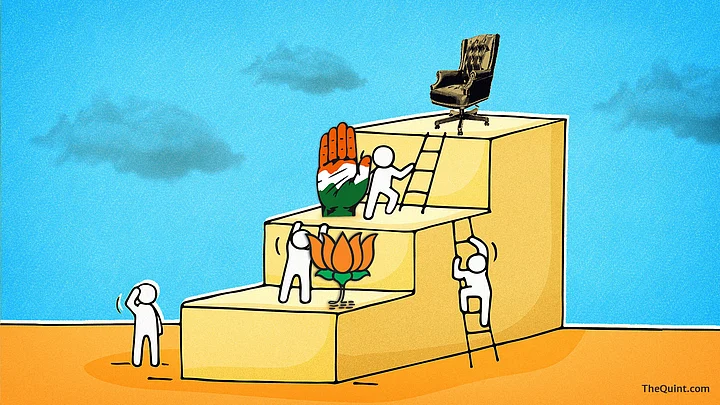(Excerpted with permission from Penguin Random House. The Raisina Model: Indian Democracy at 70 by Meghnad Desai is available on Amazon.)
‘Mandalisation’ was to change the face of political India. It ushered in the process of ‘Indianising’ the Westminster model and turning it into what I have called the ‘Raisina model’. In place of the polite decorum of British parliamentary practice came the rough and tumble of the Indian streets and pavements, a kind of rural boisterousness. The demos had arrived finally, shoving aside the bhadraloks and the ashrafs, the Oxbridge graduates and the established dynasties.
India was learning to adapt democracy to its own genius. It has been a tumultuous, tortuous but glorious process, and has entrenched democracy even deeper into India’s soil.
There was, however, a snag. The privilege of reservation had helped the Scheduled Castes, but only superficially. Already by the 1960s, the members of the Scheduled Castes had renamed themselves Dalits (crushed) rather than Harijans (God’s people) which is what Gandhi had called them.
There are jatis among the Dalits, and a small number of ‘advanced’ jatis benefited, forming a ‘creamy layer’. But the vast majority remained economically deprived. There was also no doubt that the Dalits had not achieved equality of rank. Their treatment by the upper castes had not changed over what was then thirty years of independence any more than it had over the previous three millennia.
Representing Dalit Rights
The situation was even worse among the Scheduled Tribes. It was obvious to their more radical leaders such as the Mizo leader Laldenga that the Right to Reservation was not enough. Political activity was needed to harness the levers of power of the State to achieve progress. Political activity meant electoral activity through parties which would advance the cause of the deprived majority.
Kanshiram was a Dalit employed in the public sector. He began to organise his fellow Dalits in public sector jobs. The trade union he formed in 1971, the All India Backward and Minority Communities’ Employees Federation, was turned into a political party, the Bahujan Samaj (Majority People) Party in 1984.
The idea was to harness the vote bank of fellow Dalits to get representatives elected to state Assemblies and the Parliament to advance the Dalit interests.
Reinforcing Elite Rule
Like Lohia, Kanshiram was an original political thinker. He figured out that fractions of the electorate such as represented by Dalits could only wield power if there was no hegemonic single party dominating the national political scene. Thus, political stability in terms of single-party majority was not desirable for every group in India.
As far as the socially deprived classes were concerned, such stability reinforced elite rule. That, after all, had been the history of the previous forty years of Congress rule. Despite much socialist rhetoric, only the educated upper caste elite had benefited from the public investment in higher education and public sector industries.
The Dalits had remained at the bottom of the social order. That way was not the one Dalits should choose. It was a fragmented party structure with no single dominant party which gave the best chance of empowering the weak minority groups.
Challenging Congress’ Upper Caste Hegemony
The other jati groups saw the logic of this argument. Their jatis were tiny compared to Dalits but consolidation of jatis of similar status gave weight to their vote bank. In the Bihar–UP (BUP) belt, also called the cow belt, the young leaders influenced by Lohia’s thought began to organise parties which would consolidate vote banks.
As none of the clusters of jatis could command a majority, they had to form coalitions of similar jati-based parties to achieve a majority which could challenge the established hegemonic Congress with its upper caste leadership.
The factions of the Janata Party such as Janata (United) or Socialist (S) became useful as vehicles of the Mandal politics. New parties were launched such as the Rashtriya Janata Dal (RJD) led by Lalu Prasad Yadav in Bihar and the Samajwadi Party in UP led by Mulayam Singh Yadav, and they mobilised the Yadav vote which was sizeable in the BUP region.
Both these leaders had come of age during the popular movement launched by Jai Prakash Narayan against Indira Gandhi and had been influenced by Lohia’s thinking. To strengthen their electoral prospects, they also actively cultivated the Muslim vote.
Socialism’s Indian Avatar
At long last, socialism was taking on an Indian garb which communism in India had failed to do. It had failed to fulfil the promise it had made in the 1950s. It gained strong footholds in West Bengal and Kerala, but the communists did not spread nationally.
Jai Prakash Narayan and Lohia had understood the compulsions of liberal democracy in India, which neither the Congress nor the communist parties had grasped. The Congress had what many saw as its sense of entitlement, thanks to its role in the independence movement. The communists simply followed established international Marxist theories.
China had succeeded in fashioning its own path, ignoring the Soviet diktat. Indian communism lacked any original thinker of the quality of Mao Zedong (whatever his later failures).
‘Indianising’ the Westminster Model
By the time the opportunity to exploit the gap left by the weakening of Congress hegemony came, it was too late for the communist movement; it had never understood caste.
Mandal deepened the process of ‘Indianising’ the Westminster model. It appeared strange in the eyes of the anglophile as well as the anglophone politician of the older generation. The new generation of leaders spoke an earthy Hindi or another local language rather than Oxbridge English.
They dressed in dhoti and kurta. Their manners, be it in the legislative chamber or the chief minister’s bungalow, were unappealing. They were (shock and horror) desi (Indian)!
(Breathe In, Breathe Out: Are you finding it tough to breathe polluted air? Join hands with FIT in partnership with #MyRightToBreathe to find a solution to pollution. Send in your suggestions to fit@thequint.com or WhatsApp @ +919999008335)
